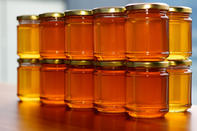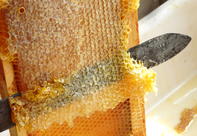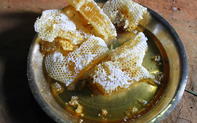Honey is a sticky sweet substance made by bees (honey bees, bumble bees and stingless bees) as well as certain wasps and ants.

It is also used by honeybees as a food source for the bee brood (an essential food for the young bees) and during times of food shortages. It has been used by man for more than 8 000 years as a source of food and as a medicine.
How is Honey Made?
Honey is made from the nectar of flowers, sugary excretions of insects or sweet plant juices. Scout bees fly in search of nectar and return to the hive to communicate (by dancing) the location of the nectar source. Nectar is then collected by forager bees who store it in their crops (honey stomachs).
Returning to the hive, these forager bees then disgorge the nectar from their crops into the crops of the processor bees near the entrance of the hive. The nectar is taken to the honeycomb - usually in the top of the hive, away from the queen and the brood who lives in the lower sections of the hive. Here in the honeycomb, the nectar is disgorged into the hexagonal (six-sided) cells.
“Every time a new load of nectar is added to the cell, the processor bees add ‘invertase’ an ezyme which breaks down the sugar (sucrose) into glucose (blood sugar) and fructose (fruit sugar)”, explains David Tarpy, associate professor of entomology at North Carolina State University. Nectar contains about 70% water, while honey contains about 17 - 18% water.
So, to reach the sticky consistency of honey, moisture from the sugary nectar must be evaporated. This is done by the constant fanning of the bees’ wings. When water has sufficiently evaporated and the right consistency is reached (honey is now ‘ripe’), the cells of the honeycomb are sealed by ‘capping’.
These beeswax caps prevent moisture from penetrating. When capped, the honeycomb is ready to be harvested or fed to baby bees. Pollen is mixed with honey before feeding the young bees the protein-rich mix.
Honey Statistics
Making honey is hard work. According to the American Bee Journal, a honeybee will visit 50 - 100 flowers on a collection trip and will produce 0.8 g of honey during her lifetime. A study in 2005 by the Department of Water and Forestry of South Africa estimated that 15 kg of honey per hive can be produced in a year.Harvesting Honey

Beekeepers harvest honeycombs by collecting and removing the full honeycomb frames from the hive. The beeswax caps, sealing the cells where the honey is kept, are scraped off with a blade and frames are then placed in an extractor.
The extractor is usually a centrifuge (revolving basket) that spins the frames at high speed. This rotational power forces the honey out of the honeycomb. The delicate empty honeycombs are returned to the hive where the bees remove the leftover honey and start repairing and cleaning each cell. Producers of raw honey extract honey at room temperature and do not use a centrifuge to extract honey.
After extraction from the honeycomb, the honey may be filtered to remove honeycomb wax and other particles. Sometimes heating speeds up the process, but will produce honey that can not be classified as ‘raw honey’. Honey is then bottled and labelled.
Ingredients of Honey

Honey is made from nectar and consist of sugars (38% fructose, 31% glucose, 5% dextrin and 1.5 - 3% sucrose), protein (0.5 - 2,3%) almost all trace elements (such as iron, phosphor, magnesium, calcium) as well as organic acids and between 18 - 20% water.
Honey also contains certain enzymes - invertase, diastase, amylase, phosphatase - that assist with the metabolising of honey. Hоnеу made frоm dіffеrеnt рlаntѕ will not only taste and smell different but will vary in its ingredients.
For example, the vitamins in honey (B1, B2, B3, B5, B6, H, K, C, E, PP, provitamin A) іѕ іnсrеаѕеd bу іnсrеаѕіng thе аmоunt оf роllеn іn the honey. Variations in taste are clear when comparing honey made from, for example, citrus blossoms (light and slightly citrusy) and eucalyptus flowers (darker in colour with a stronger, almost medicinal taste).
By Marinda Louw